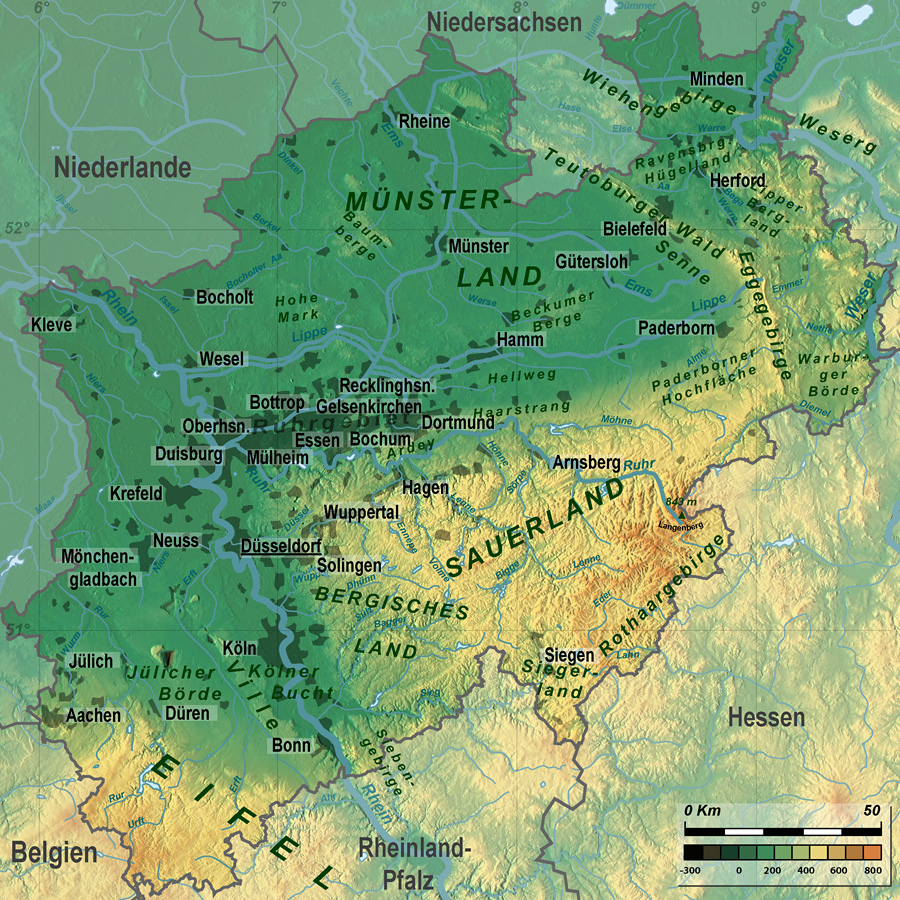North Rhine-Westphalia - Regions and people
Last year North Rhine-Westphalia celebrated its 70th anniversary. On 23rd August 1946, the British military forces turned the Prussian province Westphalia and the northern part of the Prussian Rhine province Nordrhein into the federal state of North Rhine-Westphalia, which also incorporated the Land Lippe in 1947. Located in West Germany, it borders the German federal states of Lower Saxony, Hesse, Rhineland-Palatinate and it is situated in Central Europe, sharing its western borders with the Netherlands and Belgium.
The surface of 34,110 square kilometres is home to 17.9 million people. According to the size of its population, North Rhine-Westphalia is the biggest federal state in Germany and according to its surface, it is the 4th biggest behind Bavaria, Lower Saxony and Baden-Württemberg. The capital is Düsseldorf with around 650,000 people. It is the 2nd biggest city of the state behind Cologne, which has got 1.1 million inhabitants. The two cities are followed by Essen (588,000) and Dortmund (586,000).
North Rhine-Westphalia is one of the leading economic regions in Germany and Europe, with key industries and thousands of successful small and globally famous medium-sized companies, as well as numerous headquarters of international conglomerates. 29 of the 76 German major cities are located in this highly urbanised area. The agglomeration of Rhein-Ruhr in the centre of the state is populated by ten million inhabitants and belongs to the 30 biggest agglomerations in the world and it is also the centre of a European city region. With a contribution of 22 percent to the German gross domestic product, North Rhine-Westphalia is the region with the highest economic power in Germany. If it was a sovereign nation in Europe, it would be closely behind the Netherlands on rank no. 7.

Besides the urban areas in Rheinland and Ruhr, there are also some extremely rural areas in North Rhine-Westphalia which feature a strong economic performance. Agriculture is performed on a surface of 16,500 square kilometres, which is almost 50 % of the entire state. Almost 25 % of North Rhine-Westphalia is covered by forests; nearly 9,000 square kilometres. Christmas trees, for example, are cultivated on an area of 15,000 hectares in the Sauerland, which makes it the biggest area for Christmas trees in Germany. Christmas tree farmers of the Sauerland chop off 8 million Christmas trees per year.
At the same time, the region is characterized by an agricultural variety with high recreational value and tourist attractions. With nearly 50 million overnight stays, North Rhine-Westphalia is the third most popular tourist destination in Germany.
The natural scenery is characterized by the Rhine area in the west, the mountains of Eifel, Bergisches Land, Sauerland and Siegen-Wittgensteiner Land in the south and south-east, the mountains of Teutoburger Wald in the east and the parklands of the Münsterland in the north.
North Rhine-Westphalia also features various distinct cultures. There are especially lots of differences between Rheinland, on the one hand, and Westphalia and Lippe, on the other hand. The northern part of the agglomeration Rhein-Ruhr is dominated by the Ruhr area, whose fast economic development is based on the industrialization and the coal, iron and steel industry. Since the decline of these industries in the 1960’s, the area experienced a structural change, being part of a global economy that is characterized by globalization.


 De
De